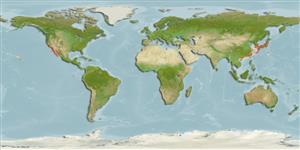>
Acropomatiformes (Oceanic basses) >
Stereolepididae (Giant seabasses)
Etymology: Stereolepis: Greek, stereos = dense + Greek,lepis = scale (Ref. 45335).
Eponymy: Gigas was a giant in Greek mythology, the child of Uranus and Gaea. The name is applied to taxa that are giants of their kind. (Ref. 128868), visit book page.
More on author: Ayres.
Environment: milieu / climate zone / depth range / distribution range
पारिस्थितिकी
समुद्री ड़िमरसल; गहराई सीमा 5 - 46 m (Ref. 2850). Subtropical; 41°N - 16°N
Eastern Pacific: Humboldt Bay in California, USA to Mexico. Northwest Pacific: Japan (Ref. 559).
आकार / वज़न / Age
Maturity: Lm ? range ? - ? cm
Max length : 250 cm TL पुल्लिंग / अलिंग; (Ref. 40637); अधिकतम प्रकाशित वज़न: 255.6 kg (Ref. 4699); अधिकतम सूचित उम्र: 75 वर्षो (Ref. 4563)
Occur on rock bottoms; near shore, outside kelp beds and along drop-offs (Ref. 2850). Large specimens usually found deeper than 30 m, small ones over sand and in kelp beds mostly from 12-21 m (Ref. 2850). Aggregate for spawning in summer (Ref. 2850). Pelagic spawners (Ref. 56049). Longevity of 90 to 100 years (Ref. 56049) stemmed from speculation on the age of a 557 lb fish caught in 1962, but the oldest age determined from otoliths of a 435 lb fish was 72 to75 years (Ref. 4563). Validated age so far is up to >50 years using bomb radiocarbon (A.H. Andrews, pers. comm.)
Pelagic spawner (Ref. 56049).
Eschmeyer, W.N., E.S. Herald and H. Hammann, 1983. A field guide to Pacific coast fishes of North America. Boston (MA, USA): Houghton Mifflin Company. xii+336 p. (Ref. 2850)
IUCN Red List Status (Ref. 130435: Version 2024-1)
Threat to humans
Harmless
Human uses
मात्स्यिकी: व्यापारिक; आखेट मत्स्य: हां
साधन
Special reports
Download XML
इंटरनेट स्रोत
Estimates based on models
Preferred temperature (Ref.
123201): 14.8 - 23, mean 20.9 °C (based on 48 cells).
Phylogenetic diversity index (Ref.
82804): PD
50 = 0.8125 [Uniqueness, from 0.5 = low to 2.0 = high].
Bayesian length-weight: a=0.01122 (0.00514 - 0.02450), b=3.04 (2.87 - 3.21), in cm total length, based on all LWR estimates for this body shape (Ref.
93245).
Trophic level (Ref.
69278): 4.5 ±0.80 se; based on food items.
Generation time: 22.7 ( na - na) years. Estimated as median ln(3)/K based on 1
growth studies.
लौटाव (Ref.
120179): बहुत नीचे, न्यूनतम जनसंख्या दुगनी समय अवलागत 14 महीने। (tm=11; tmax=75; also Musick et al. 2000 (Ref.
36717)).
Fishing Vulnerability (Ref.
59153): Very high vulnerability (86 of 100).
Climate Vulnerability (Ref.
125649): High vulnerability (63 of 100).
Nutrients (Ref.
124155): Calcium = 24.1 [14.9, 48.7] mg/100g; Iron = 0.762 [0.455, 1.241] mg/100g; Protein = 20.1 [18.5, 21.9] %; Omega3 = 0.273 [0.147, 0.532] g/100g; Selenium = 35.2 [13.1, 79.3] μg/100g; VitaminA = 10.6 [2.9, 36.7] μg/100g; Zinc = 0.435 [0.308, 0.633] mg/100g (wet weight);
